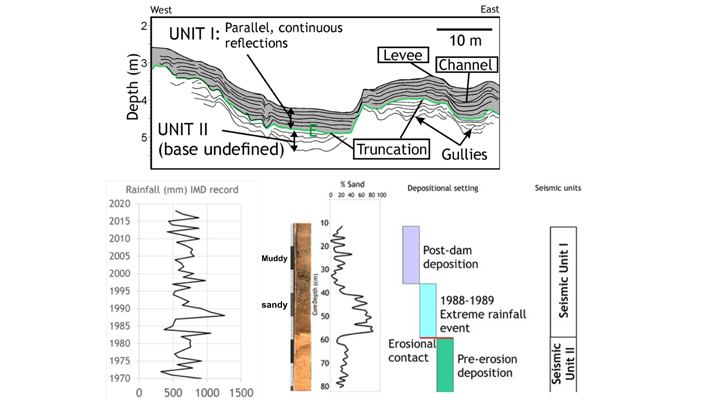A collaborative work between scientists from institutions across India and abroad, including IISER Pune, and the University of Colorado-Boulder (USA), studied the sediment records of human-made lakes, referred to as talavs, to understand the effects of past climate extremes. Faculty member Dr. Sudipta Sarkar who is part of this study describes here a recent research paper from this collaborative work.
------------------------------------------------
Echoes beneath the Human-made Lakes reveal India’s hidden Climate risks
By Sudipta Sarkar, Department of Earth and Climate Science, IISER Pune
Beneath the quiet waters of western India’s human-made reservoirs lie stories of resilience, adaptation, and climate vulnerability. What appear to be placid lakes, locally known as talavs, have quietly documented centuries of monsoon variations, floods, and human actions. New research reveals these water bodies are more than just remnants of ancient engineering, they are sentinels of changing climate.
In a collaborative work from teams across India and abroad, we decoded sediment records preserved in human-made lakes to understand how human-environment systems in semi-arid India have responded to past climate extremes.
Published recently in the journal Quaternary Environments and Humans, this study combines satellite imagery, seismic lake profiling, sediment chemistry, and landscape modelling to reconstruct a century of environmental change in the Bhima watershed, one of Maharashtra’s most climate-stressed river basins.
An Archive of Water and Sediment
Talavs are a key part of South Asia’s history with water. They were built mostly during the Mughal era and later expanded by British administrators. These reservoirs were created to collect seasonal rainwater in various regions. Today, thousands of these water bodies can be found in the semi-arid landscape. They play an important role in irrigation and recharging groundwater.
But these reservoirs do more than just a water resource, they accumulate sediments washed in from surrounding hills, layer upon layer, year after year. Each layer captures traces of minerals, and chemical fingerprints that reflect rainfall intensity, erosion, and land use.
By analyzing sediment cores drilled from two talavs, Matwali near Beed and Indira Bazar near Pune, our study pieced together how erosion and run-off have fluctuated with changing rainfall over the past hundred years.
Sediments Tell the Tale of Floods
The sediments reveal a striking contrast between the drier Marathwada and the wetter Madhya Maharashtra divisions of the Bhima watershed. Both regions experience the Indian Summer Monsoon, but their responses differ sharply.
At Matwali, our team identified a thick, coarse-grained sediment layer deposited during the catastrophic 1988-89 monsoon, when torrential rains swept through the uplands. This flood, the strongest in three decades, eroded large volumes of soil. In contrast, the Indira Bazar site near Pune showed steady, fine-grained sedimentation, signalling a more stable catchment despite intense rainfall.
Modelling landscape evolution
To understand landscape dynamics, our team used a landscape evolution model, simulating how rainfall, rock type, and land erodibility together shape erosion patterns. The model confirmed what the sediments hinted catchments in drier zones erode faster during short, intense rainfall bursts, amplifying flood and sediment erosion risks. The drier regions are not just drought-prone; they are also flood-prone when extreme rains strike. Therefore, sustainable land management in such watersheds must account for both ends of the climate spectrum.
The Human factor in Climate Archives
The study underscores that human-made systems such as, dammed reservoirs may serve as climate archives. Their sediment records remind us that climate risk in semi-arid India is deeply intertwined with human decisions made decades ago. Our study proposes that recognising talavs as scientific observatories could transform how India monitors environmental change. Regular sampling and analysis of these sedimentary archives could provide early warnings of shifting hydroclimatic trends.
Lessons for a Warming Future
As climate change affects South Asia more intensely, it is important to understand how local landscapes respond to both heavy rainfall and drought. The lessons from talavs reach beyond India’s drylands; they provide a guide for evaluating vulnerability in other monsoon-fed areas of the Global South. These reservoirs were created to withstand uncertainty. If we pay attention to what their sediments reveal, they may assist us in getting ready for climate change uncertainty that lies ahead.

Citation:
Atreyee Bhattacharya, Sudipta Sarkar, J.S. Leonard-Pingel, A.V. Michelson, A Anoop, P.K. Mishra, S. Chakraborty, K Bajaj, U Singh, V Petryshyn, R. Ray, P.D. Sabale, A Bhattacharya, M. Kirby, A. Bazaz, Sedimentary records from human-made talavs reveal climate risks in semi-arid watersheds of India, Quaternary Environments and Humans, Volume 3, Issue 2, 2025, 100061, ISSN 2950-2365, https://doi.org/10.1016/j.qeh.2025.100061.


